The Only 5 n8n Alternatives to Consider in 2025
Looking for the best alternatives to n8n?
In this guide, you’ll get a side-by-side comparison of today’s top automation tools—like Zapier, Make, Flowise, Relay.app, and Big Sur AI.
⚡ See at a glance what each tool does best, where they fall short, and how their pricing stacks up.
🔐 We’ll break down real-world feedback from users switching away from n8n, so you know the key reasons to consider a change.
🔍 Whether you’re after no-code simplicity, advanced AI features, or enterprise-grade security, you’ll find the details you need below to pick the right platform for your workflow.
Let’s dive in!
Reasons why people look for n8n alternatives
Here are the top 3 reasons users are switching away from n8n to alternative platforms, based on real-world discussions, reviews, and deep-dive comparisons:
Reason #1: Enterprise features feel immature
Advanced permissions, robust SSO, audit logs, and complex user management often lag behind what’s expected in a secure, scalable business setting. Users on GitHub and Reddit echo this, with one stating, “n8n’s access controls are basic if you’re scaling up.”
Reason #2: Self-hosted performance and maintenance overhead
Many mention that self-hosted n8n instances require frequent fixes, manual updates, and careful resource monitoring. On community forums:
- Frequent “memory leaks and sudden crashes” impact reliability
- “Non-trivial time investment” for maintenance, per an IT manager
Reason #3: Limited AI-native workflows
User feedback highlights that n8n’s AI integrations are surface-level compared to platforms designed with AI at their core. As one power user put it: “It just feels tacked on—and anything beyond basic OpenAI usage needs custom work.”
🚨 Other concerns: Steep learning curve, basic error handling, and slow response to feature requests are also commonly cited by switching users.
The Only 5 n8n Alternatives to Consider in 2025
| Tool | Best For | Key Strength | Drawbacks | Pricing |
|---|---|---|---|---|
| Big Sur AI | Business users seeking simple, AI-native workflows | Unified AI-powered automation with strong data security | Not open-source, less suited for non-AI workflows | Custom, not publicly listed |
| Zapier | Small businesses, operations, non-technical users | Massive integration library, reliable low-code automation | High cost at scale, limited advanced workflow logic | Free (100 tasks), then $29.99/mo+, usage-based |
| Make | No-code teams, IT pros needing visual, multi-step flows | Visual, drag-and-drop workflow builder with extensive integration | Steep learning curve, some unreliability, support for complex/niche cases limited | Free (1,000 ops), then $10.59/mo+, usage limits |
| Flowise | AI/LLM developers and teams building visual AI flows | Drag-and-drop LLM agent builder, open-source, real-time collab | Tricky deployment, sparse docs, scales poorly | Free (5 runs), Pro $39/mo (2,000 runs), Enterprise custom |
| Relay.app | Teams requiring collaboration, approval steps, human-in-loop | No-code, deep SaaS integration, human-step controls | Fewer integrations, less logic flexibility, transparency concerns | Free (200 runs), Team $49/mo (2,000 runs), Business $249/mo |
| n8n (reference) | Developers, open-source fans, self-hosters | Customizable, open-source, self-hosted automation | Steep learning, complex setup, immature enterprise features | Free (self-hosted), paid cloud tiers |
1. Big Sur AI
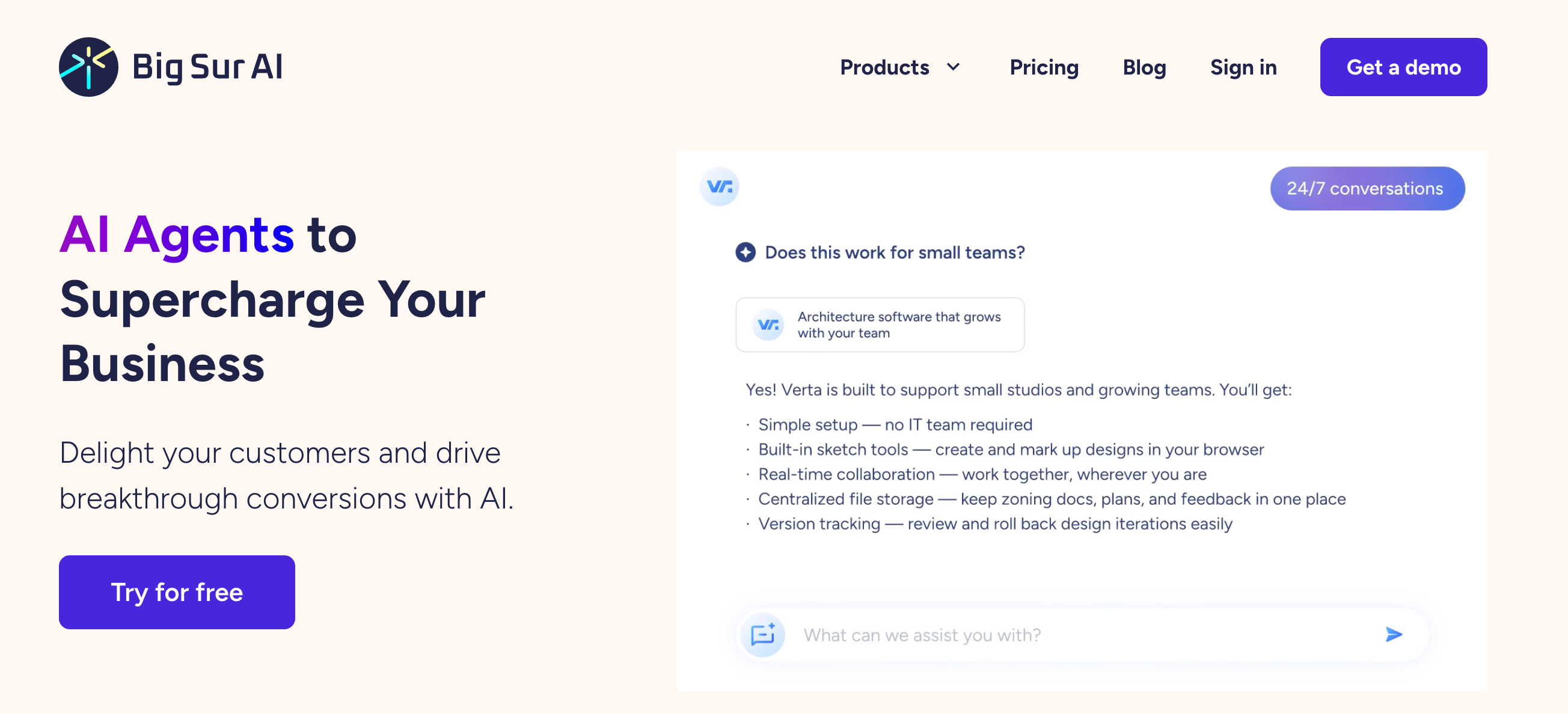
Public reviews: 4.7 ⭐ (G2, Capterra)
Similar to: Chatbase, Ada
Typical users: All customer-facing teams, ecommerce businesses
Known for: AI-powered customer support chatbots and automation
What is Big Sur AI?
Big Sur AI (that’s us 👋) is an AI-first chatbot assistant, personalization engine, and content marketer for websites.
Designed as AI-native from the ground up, our agents deliver deep personalization by syncing your website’s unique content and proprietary data in real time. They interact naturally with visitors anywhere on your site, providing relevant, helpful answers that guide users toward their goals — whether that’s making a decision, finding information, or completing an action.
Key Differences from Botpress
Big Sur AI is built from the ground up to crawl, understand, and sync with your website's content automatically—no manual setup. Within minutes, it launches a personalized AI agent that can reside anywhere on your site (product pages, CTAs, etc.)
Key Features and Capabilities of Big Sur AI
- Custom AI Training: Automatically crawl every page on your website. Select which pages to include and exclude from the AI chatbot’s training.

- Flexible Customization: Tailor your agent to fit your website experience and brand.

- Automate AI Actions & Workflows: You can instruct the AI agent to do specific tasks or fire automated workflows when certain criteria are met when visitors engage. You can fire actions like take a visitor’s information, trigger automated subscriptions, update records, etc.

- AI Content Marketer: Ask Big Sur’s AI agent to automatically create landing pages based on your documentation data or frequent conversation topics with visitors.

- Chatbot Insights: Gives you deep analytics on what customers are asking, what’s converting, and where drop-offs happen—so you can optimize your site for conversions.

Pros and Cons of Big Sur AI
Pros: What do brands like most about Big Sur (according to reviews)?
- More than a chatbot: In short, Big Sur AI combines AI chatbot, website personalization & conversion optimizer, landing page builder, and visitor support into one platform.
- Easy setup: Type in your website’s URL into Big Sur AI’s hub (try it here), and you’re live in minutes—no dev team needed.
- AI-first: Big Sur was built from the ground up to leverage AI. All features have native AI capabilities that make legacy providers obsolete (general product searches, non-AI product recommendations, generic chatbots, etc.).
Cons: What do people dislike about Big Sur AI?
❌ Limited Integration Options
Users report that Big Sur AI offers fewer native integrations with third-party platforms compared to competitors like Intercom or Chatbase, which can hinder streamlined workflows and automation.
❌ Customization Constraints
Customers have noted restrictions in customizing the chatbot’s interface and behavior, which limits the ability to tailor the customer experience fully to specific brand guidelines.
Pricing: How much does Big Sur AI cost?
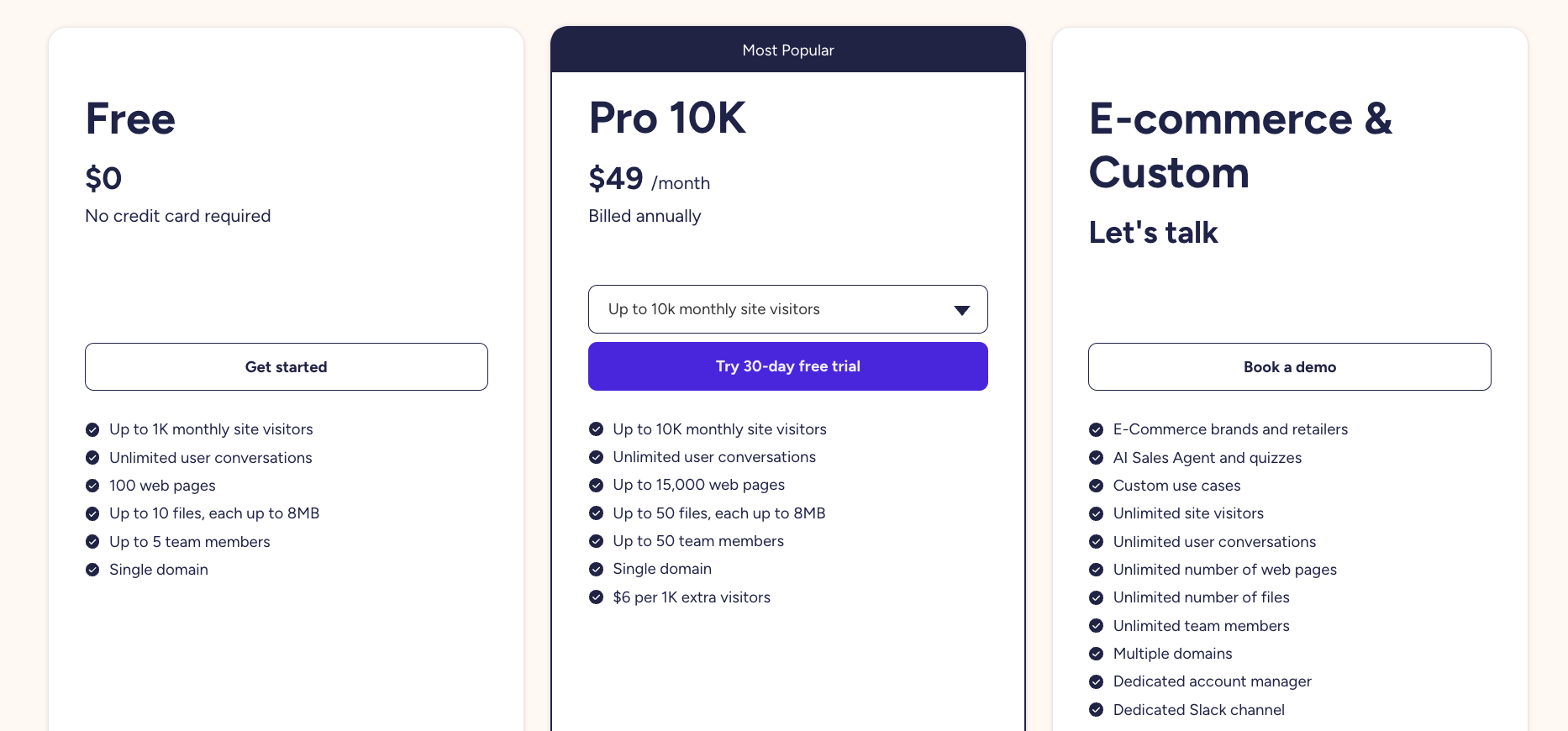
Big Sur AI’s pricing gives you more volume than Chatbase, and doesn’t have as many volume paywalls that force you to upgrade (more on this below).
Choose from 3 plans:
- Free - $0/month, supports up to 1,000 monthly site visitors, unlimited user conversations, 100 web pages, 10 files (8MB each), and 5 team members.
- Pro 10K - $49/month (billed annually), supports up to 10,000 monthly site visitors, unlimited user conversations, 15,000 web pages, 50 files (8MB each), 50 team members, and one domain. Additional visitors at $6 per 1,000.
- Custom - Contact for pricing, unlimited site visitors, conversations, pages, files, team members, multi-domain support, and a dedicated account manager with Slack channel.
2. Zapier
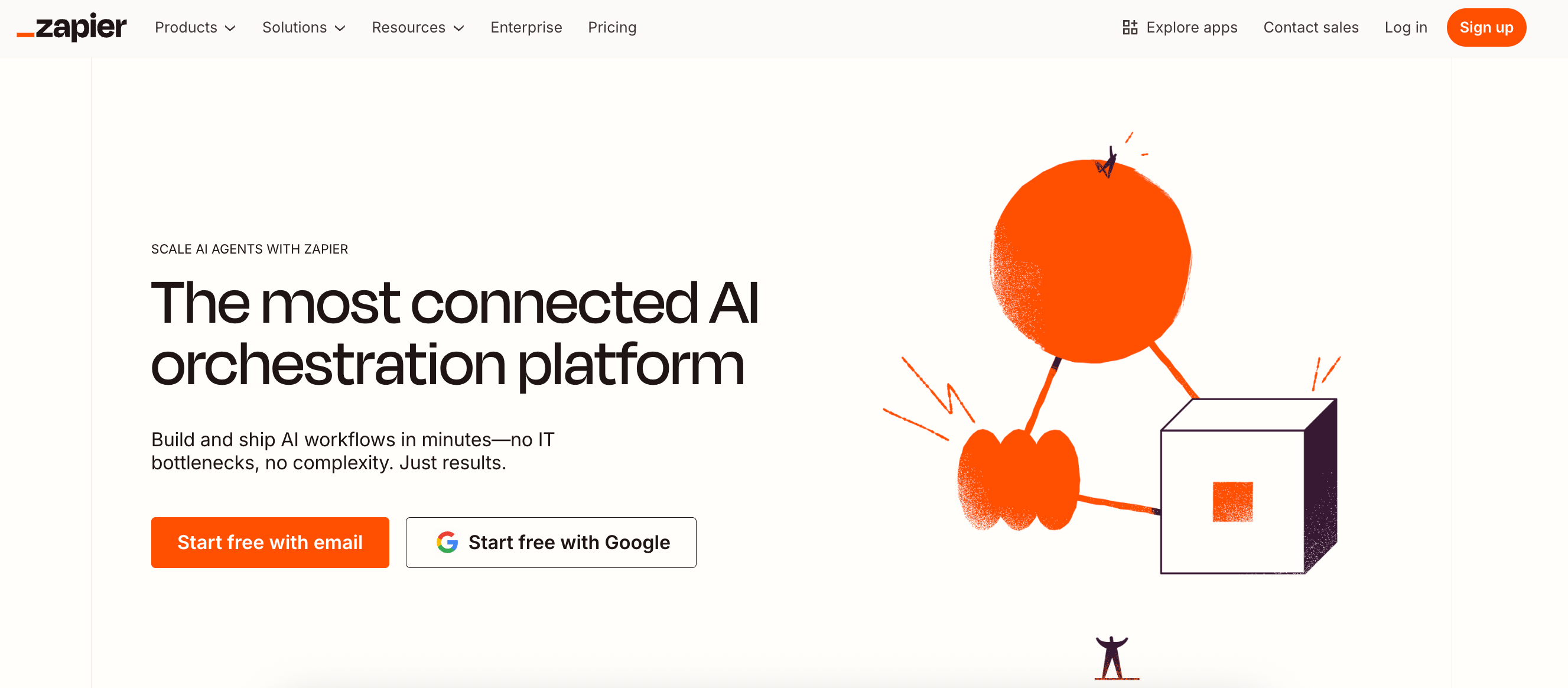
Public reviews: 4.7 ⭐ (G2, Capterra)
Similar to: Make, n8n
Typical users: Small businesses, operations, and marketing teams
Known for: Automating workflows by connecting apps without code
What is Zapier?
Zapier is an automation tool that connects your favorite apps and services so they work together automatically. You can create custom workflows, called Zaps, to save time on repetitive tasks without any coding skills needed.
Key Differences from n8n
Zapier is easier for beginners, has more prebuilt app connections, is fully cloud-based, and is not open-source. n8n is self-hostable, open-source, and offers more customization for advanced users.
Key Features and Capabilities of Zapier
- Workflow Automation (Zaps): Create automated workflows by connecting two or more apps to perform tasks based on specific triggers and actions.
- Multi-Step Workflows: Build complex automations that chain multiple actions and conditional logic, allowing processes to span across several apps and steps.
- App Integrations: Connect with a library of over 6,000 apps and services, enabling interoperability and data transfer without manual intervention.
- Conditional Logic (Paths): Set up branching logic in workflows to tailor automation outcomes based on defined conditions, such as IF/THEN rules.
- Schedule and Delay Actions: Automate tasks on custom schedules or insert delays between steps in a workflow, controlling when actions execute.
- Built-in Data Formatter: Use Zapier’s Formatter to manipulate data between apps, including text transformations, number formatting, date/time conversions, and more.
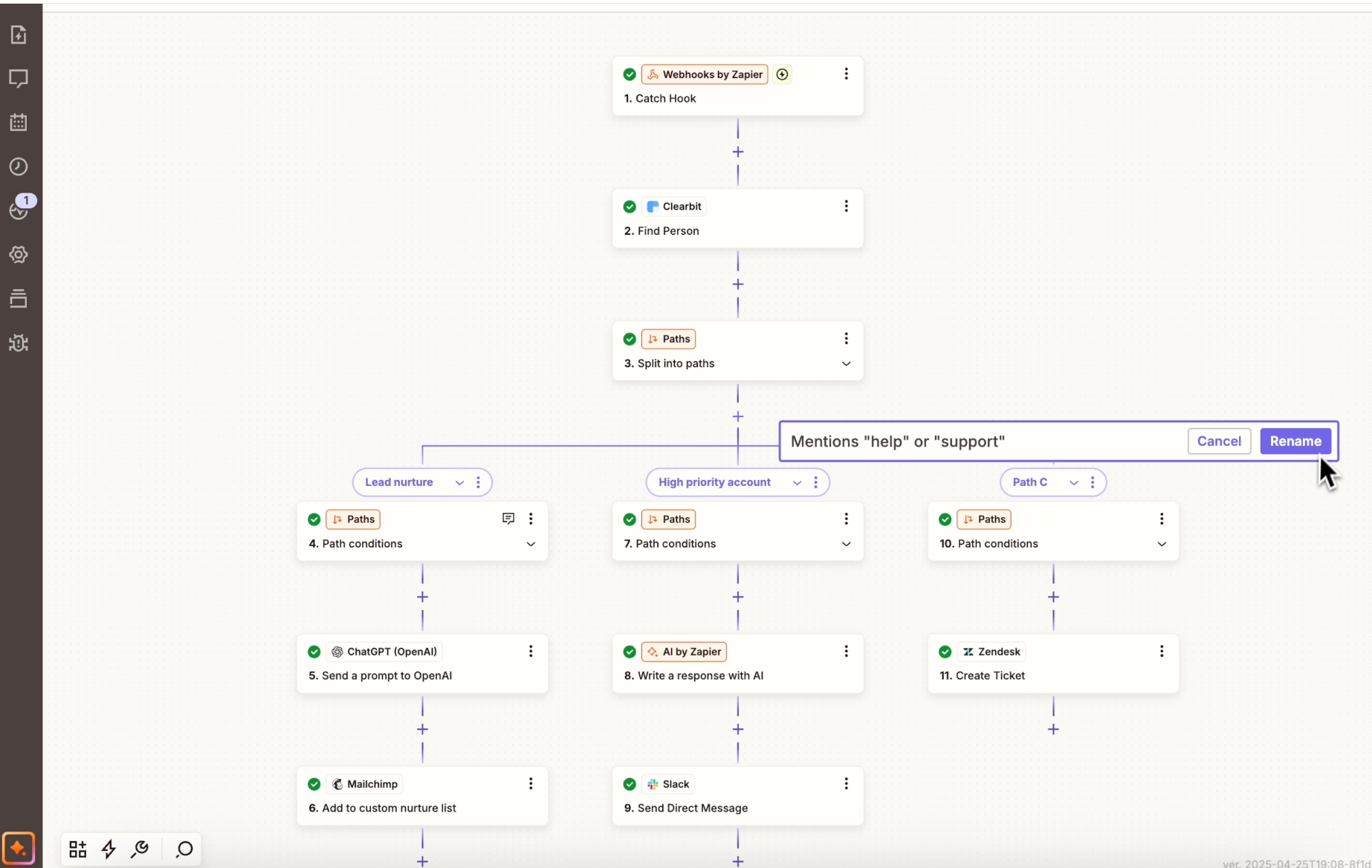
💡 Zapier enables users to automate tasks and synchronize data between thousands of apps, using customizable workflows, conditional logic, scheduling, and in-line data formatting.
Pros and Cons of Zapier
Pros: Why do people pick Zapier over other AI Agent Builders?
✅ Massive pre-built integration library
Connects with thousands of apps out of the box, covering most business needs.
✅ Intuitive, no-code workflow builder
Lets anyone automate tasks with a drag-and-drop interface—no technical skills required.
✅ Reliable automation at scale
Handles high volumes of workflows with proven stability and robust error handling.
Cons: What do people dislike about Zapier?
❌ High Cost for Scaling
Many users find that Zapier's pricing gets expensive quickly as automation needs grow or usage limits are exceeded.
❌ Limited Workflow Flexibility
Advanced users report frustration with Zapier’s restricted logic, conditional branching, and custom code capabilities compared to competitors.
❌ Clunky Error Handling
Users often mention Zapier’s error alerts can be insufficient, making troubleshooting and debugging integrations more difficult.
Pricing: How much does Zapier cost?
Zapier’s pricing is usage-based, charging by the number of “tasks” your automations run each month, with more features unlocked at higher tiers.
Choose between these 4 plans:
- Free - $0, 100 tasks/month and 5 Zaps, basic support, single-step Zaps only
- Starter - $29.99/month, 750 tasks/month, up to 20 Zaps, multi-step Zaps, filters, premium apps
- Professional - $73.50/month, 2,000 tasks/month, unlimited Zaps, advanced logic (paths), auto replay
- Team - $103.50/month, 2,000 tasks/month, unlimited Zaps, collaborative features, folder permissions
Price limitations & potential surprises
- Each plan sets a monthly task limit—exceeding it can automatically pause automations or trigger overage charges if you don’t upgrade.
- Some sought-after features (like conditional logic and premium app integrations) only unlock on higher-priced plans, potentially raising costs as you scale.
💡 Most users will need to monitor task usage closely, as popular Zaps can quickly exceed monthly limits and require a plan upgrade or extra payment.
3. Make
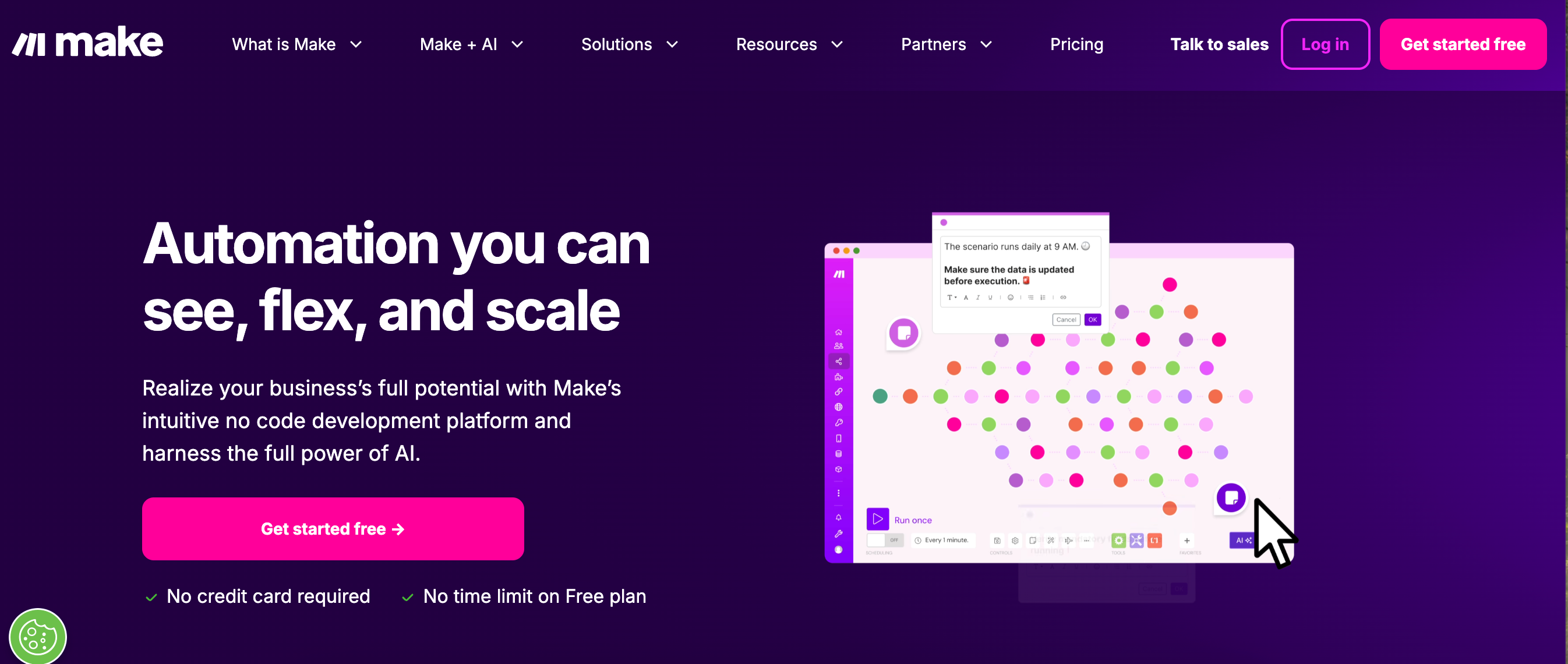
Public reviews: 4.7 ⭐ (G2, Capterra)
Similar to: Zapier, n8n
Typical users: Operations teams, IT professionals, no-code developers
Known for: Visual workflow automation and extensive integrations
What is Make?
Make is an online automation platform that helps you connect apps and services to automate repetitive tasks without coding. You can design custom workflows using a user-friendly visual interface and let your work happen automatically.
Key Differences from n8n
Make is fully visual and drag-and-drop, ideal for no-code users; more polished interface, but not open-source like n8n.
Key Features and Capabilities of Make
- Visual Workflow Builder: Drag and drop apps, triggers, and actions on an intuitive visual canvas to design custom automations across hundreds of services and APIs.
- Multi-Step Scenarios: Create complex workflows with multiple steps, including branching, filtering, iterators, aggregators, and conditional logic.
- Scheduling and Triggers: Initiate workflows based on time schedules, data changes in apps, incoming webhooks, or custom triggers.
- Thousands of App Integrations: Connect and automate processes between more than 1,500 apps and services, including support for HTTP, FTP, databases, and custom API modules.
- Advanced Data Manipulation: Transform, parse, and map data between applications with inline data tools, functions, and tools like text parser or date formatter.
- Real-Time Execution Monitoring: Inspect, debug, and track workflow runs with real-time visualization, execution logs, error handling, and instant feedback.
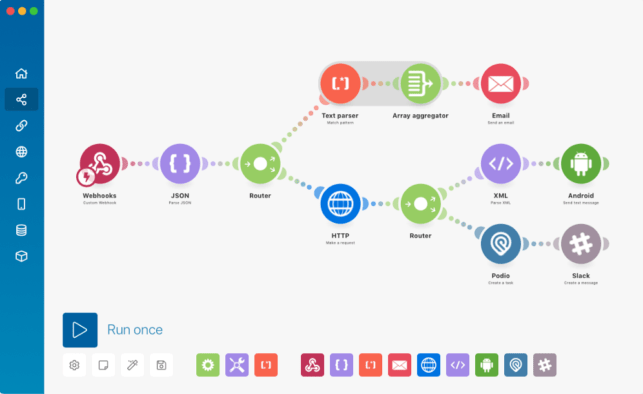
💡 Make enables users to visually build, schedule, integrate, manipulate data, and monitor automated workflows spanning thousands of apps and services.
Pros and Cons of Make
Pros: Why do people pick Make over other AI Agent Builders?
✅ Visual Workflow Builder
Make offers an intuitive, drag-and-drop interface for building complex automations without coding.
✅ Extensive Integration Library
It natively connects with thousands of apps, making multi-app workflows easy to set up.
✅ Flexible Automation Scheduling
Make offers granular control over trigger timing and workflow execution to fit diverse business needs.
Cons: What do people dislike about Make?
❌ Complex Learning Curve
Many users find Make's interface and workflow setup unintuitive and difficult for beginners.
❌ Occasional Unreliable Automations
Users report that some automations fail silently or unpredictably, making troubleshooting challenging.
❌ Limited Support for Advanced Integrations
There are complaints about Make's challenges in handling complex scenarios or niche third-party services compared to competitors.
Pricing: How much does Make cost?
Make uses a subscription-based pricing model with several tiers based on usage, features, and team size.
Choose between these 4 plans:
- Free - $0, includes 1,000 operations/month, unlimited users, and 100 MB data transfer
- Core - $10.59/month, includes 10,000 operations/month, unlimited users, 1 GB data transfer, and access to basic support
- Pro - $18.82/month, includes 40,000 operations/month, unlimited users, 20 GB data transfer, premium support, and priority scenario execution
- Teams - $34.12/month, includes 150,000 operations/month, advanced security, 150 GB data transfer, SSO, audit log, and onboarding support
Price limitations & potential surprises
- Overage charges can occur if your operation or data transfer limits are exceeded, leading to extra costs as your automations scale.
- Advanced features (such as higher priority support and security compliance like SSO) are locked behind higher-tier plans.
💡Review your anticipated usage and required features to avoid unexpected costs as your automations or team grows.
4. Flowise
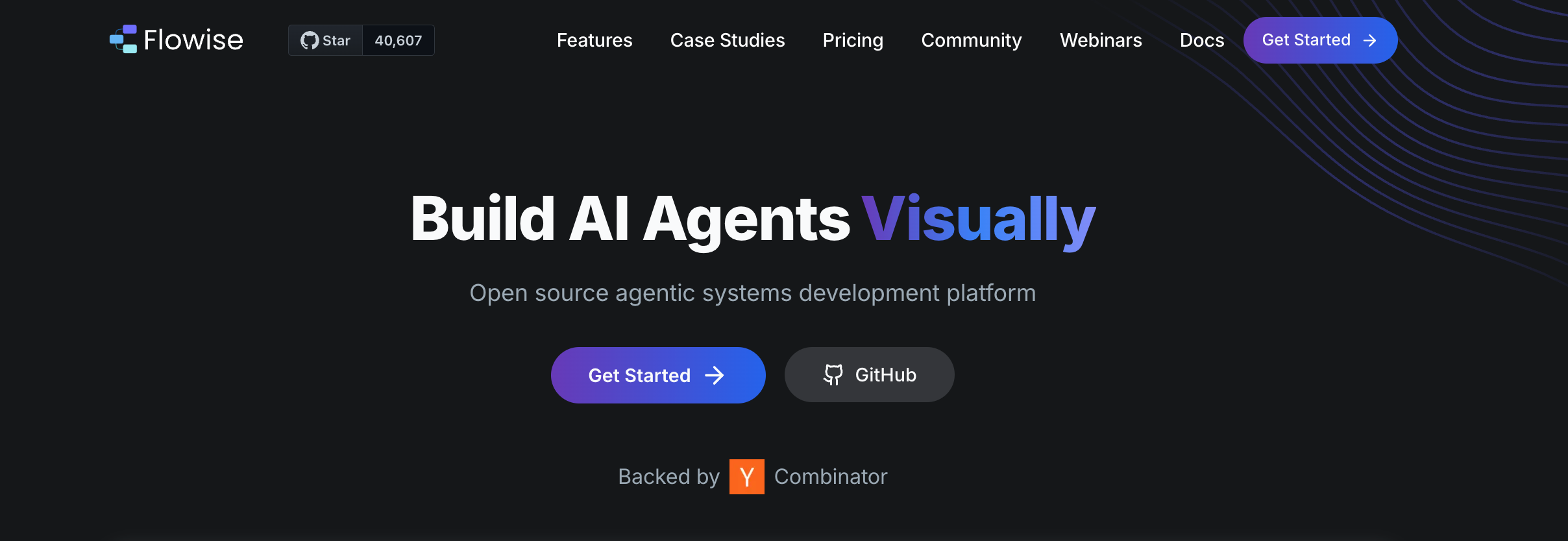
Public reviews: 4.7 ⭐ (G2, GitHub)
Similar to: Langflow, Haystack
Typical users: AI developers, data scientists, and ML engineers
Known for: Visual builder for LLM workflows and prompt orchestration
What is Flowise?
Flowise is a user-friendly tool that helps you visually build, test, and deploy AI-powered workflows using a drag-and-drop interface. It’s mainly used to create custom AI solutions without needing to write complex code.
Key Differences from n8n
Flowise is built specifically for creating AI agents with drag-and-drop simplicity. It is open-source, focuses on language models, and is more specialized for AI workflows than n8n’s general automation tools.
Key Features and Capabilities of Flowise
- Visual Flow Builder: Design and orchestrate AI workflows using a drag-and-drop, no-code interface that connects various components and APIs.
- Custom Node Creation: Develop, integrate, and reuse custom nodes to connect external APIs, large language models, or proprietary tools within workflows.
- Native LLM Integrations: Connect directly to popular large language models (e.g., OpenAI, Hugging Face, Azure, local models) for text generation, summarization, and analysis tasks.
- Data Connector Nodes: Access and work with databases, file systems, and third-party apps by using prebuilt connectors for structured and unstructured data.
- Deploy and Share Workflows: Publish workflows as RESTful APIs or web applications and manage access through built-in authentication options.
- Extensible Plugin System: Enhance platform capabilities with community or custom plugins to add new tools, integrations, or workflow features.
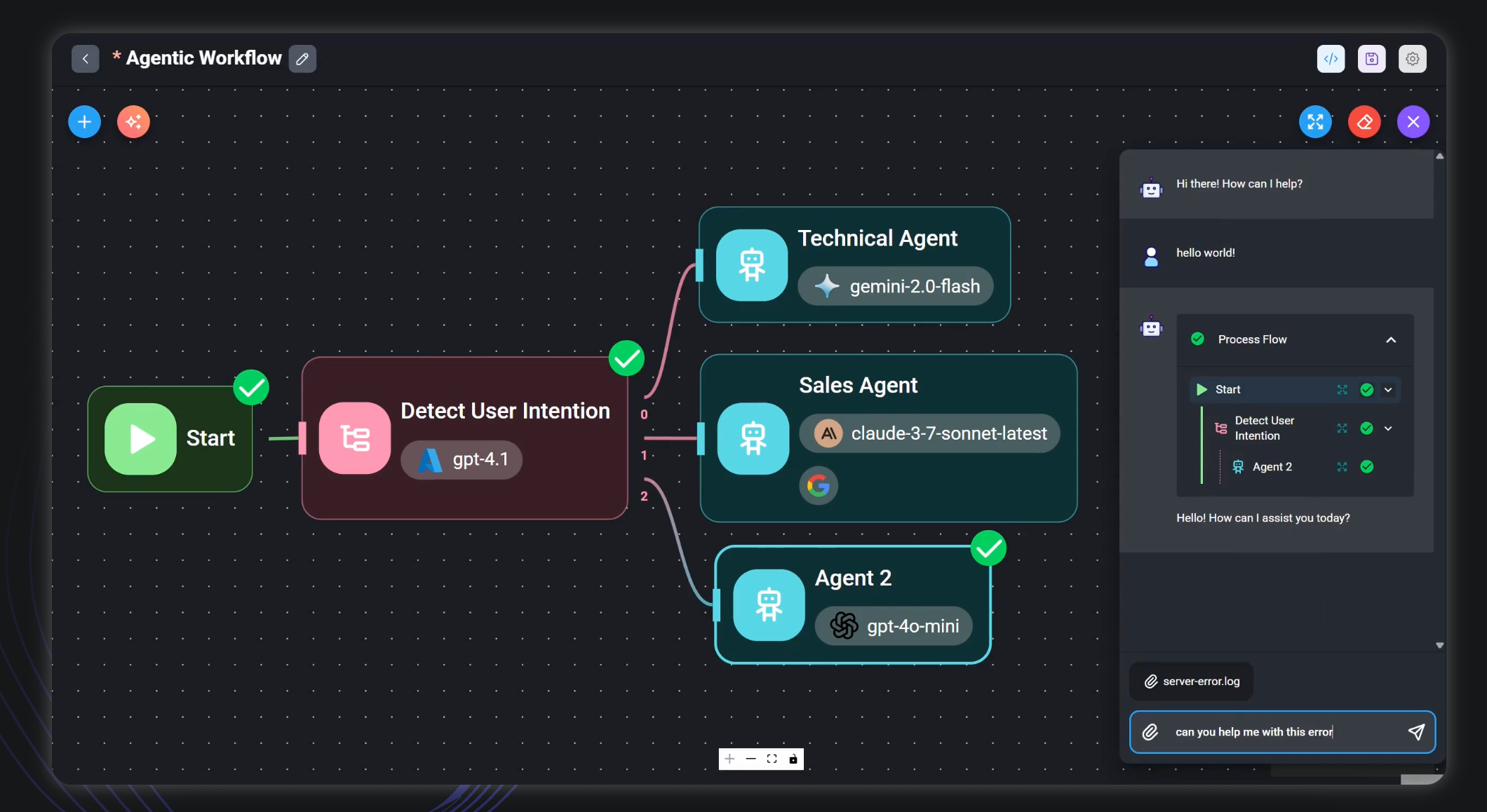
💡 Flowise provides a no-code environment to visually construct, integrate, and deploy custom AI-driven workflows using modular components and external systems.
Pros and Cons of Flowise
Pros: Why do people pick Flowise over other AI Agent Builders?
✅ Visual builder
Drag-and-drop interface lets you create and customize AI workflows with no code required.
✅ Extensive integration
Easily connects with popular LLMs, databases, and third-party tools out of the box.
✅ Real-time collaboration
Supports multi-user editing so teams can build and iterate on agents together.
Cons: What do people dislike about Flowise?
❌ Deployment Complexity
Deploying Flowise to production environments can be tricky for non-technical users.
❌ Limited Documentation
Users report that core modules and integrations often lack detailed or up-to-date documentation.
❌ Performance at Scale
Flowise can become sluggish or unreliable when handling large, complex workflows.
Pricing: How much does Flowise cost?
Flowise’s pricing is usage-based, charging by the number of workflow runs and active workflows per month.
Choose between these 3 plans:
- Free plan - $0, includes unlimited users, up to 5 workflow runs per month, and unlimited active workflows
- Pro plan - $39/month, includes unlimited users, up to 2,000 workflow runs per month, and up to 20 active workflows
- Enterprise plan - Custom pricing, includes unlimited users, custom workflow limits, dedicated support, and flexible integrations
Price limitations & potential surprises
- Workflow run and active workflow limits can restrict scaling on lower-tier plans, with overages requiring plan upgrades.
- Some integrations and support features are only available on the custom Enterprise plan, possibly adding to costs for advanced users.
💡 As your use of Flowise grows, you may need to upgrade to higher tiers to access increased workflow limits and advanced features.
5. Relay.app

Public reviews: 4.7 ⭐ (G2, Product Hunt)
Similar to: Zapier, Make (Integromat)
Typical users: Operations, product, and customer support teams
Known for: No-code workflows and collaborative automation
What is Relay.app?
Relay.app is an automation platform that lets you build workflows using AI agents to connect apps and complete tasks automatically, without coding. It's used to streamline repetitive processes and improve productivity, similar to tools like n8n.
Key Differences from n8n
Relay.app is easier for teams to collaborate on workflows, emphasizes human-in-the-loop decisions, offers built-in AI features, and is not open-source like n8n.
Key Features and Capabilities of Relay.app
- Workflow Builder: Create and customize automated workflows using an intuitive drag-and-drop interface to connect apps, actions, and approvals.
- AI Integration: Incorporate large language models (LLMs) into automated processes, enabling tasks like summarization, drafting, classification, and data extraction directly within workflows.
- Multi-app Connectivity: Link and move data across popular apps and services—such as Google Workspace, Slack, Salesforce, Notion, and Airtable—using built-in connectors.
- Human-in-the-Loop Steps: Add interactive steps that request human input, approvals, or reviews inside automated workflows, including sending tasks via email, Slack, or in-app notifications.
- Collaboration Tools: Invite team members to co-build workflows, assign roles and permissions, and leave comments or notes at each workflow step.
- Scheduling and Triggers: Start workflows automatically based on scheduled times, webhook events, or triggers from integrated applications.
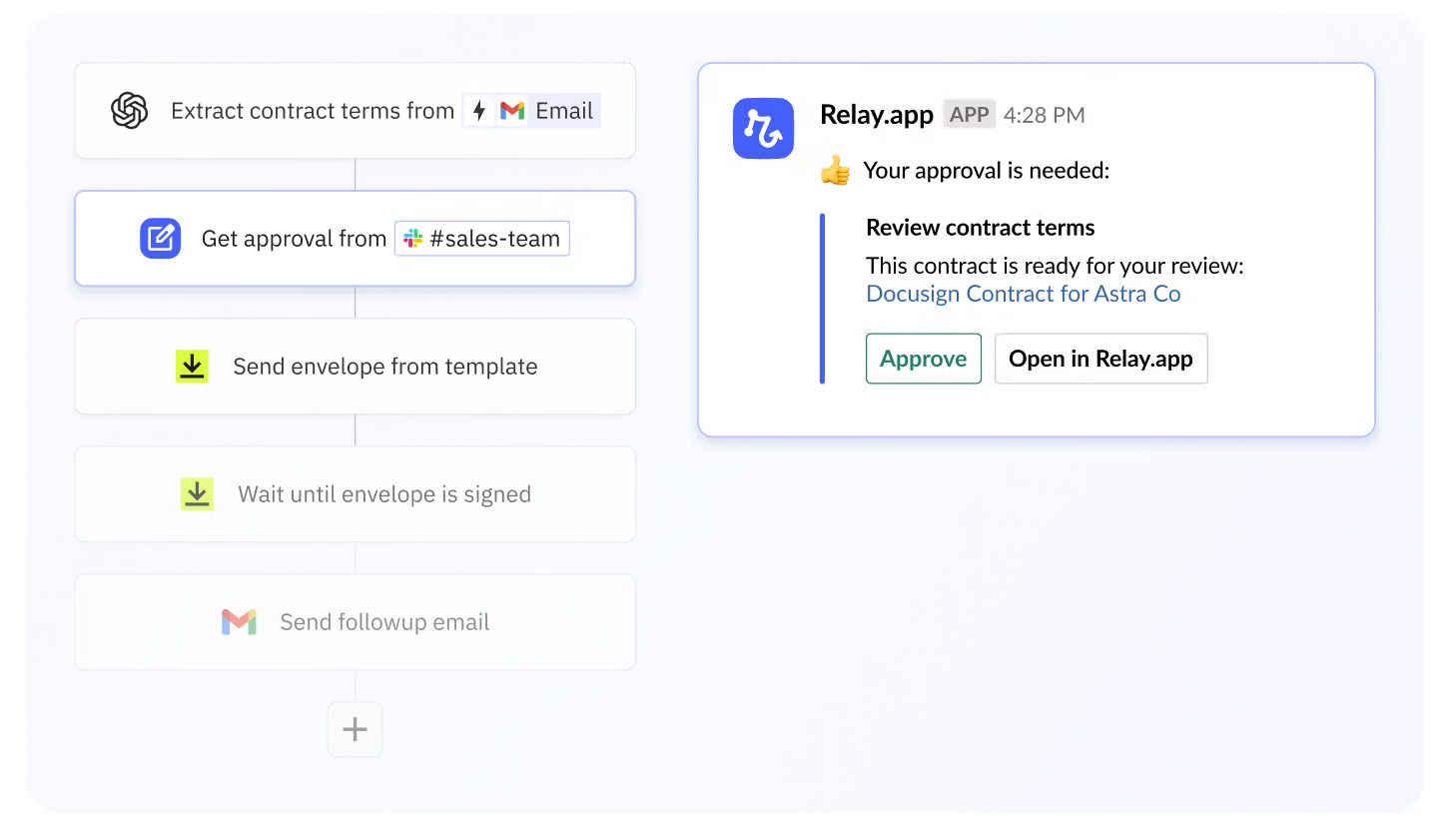
💡 Relay.app lets teams automate cross-app processes by combining AI, human decision points, and extensive app integrations in collaborative, customizable workflows.
Pros and Cons of Relay.app
Pros: Why do people pick Relay.app over other AI Agent Builders?
✅ Flexible, no-code workflows
Relay.app lets users build custom automations without writing any code.
✅ Real-time human-in-the-loop controls
It enables you to insert approvals and manual steps directly into automated flows.
✅ Deep SaaS integrations
Relay.app connects seamlessly with a broad range of business tools for end-to-end processes.
Cons: What do people dislike about Relay.app?
❌ Workflow Flexibility
Some users note that Relay.app lacks advanced conditional logic and branching compared to n8n.
❌ Integration Limitations
Relay.app’s integrations library is less extensive than established automation platforms.
❌ Transparency in Agent Actions
Several users wish for more detailed logs and visibility into exactly how agents are executing tasks.
Pricing: How much does Relay.app cost?
Relay.app’s pricing is usage-based, charging teams by run credits rather than seats.
You can currently choose between 3 plans:
- Starter – free, includes 200 run credits per month, unlimited users, and access to all integrations
- Team – $49/month, includes 2,000 run credits per month, unlimited users, and all integrations
- Business – $249/month, includes 15,000 run credits per month, priority support, enhanced security, and unlimited users
Price limitations & potential surprises
- You may exceed monthly run credits if your workflows scale up, resulting in an extra $29 for each additional 1,000 runs on the Team plan and $20 for each 1,000 extra runs on the Business plan.
- Feature sets are similar across plans, but higher pricing tiers offer more credits and improved support, rather than advanced functionality.
💡 As you ramp up usage, expect predictable charges for extra credits, but be mindful that rapid automation growth could lead to higher costs than anticipated.
Which Automation Tool Should You Choose?
- If you want the best AI-powered workflows and data security, pick Big Sur AI.
- For massive app integrations and beginner-friendly automation, go with Zapier.
- If visual workflow design and flexibility matter most, try Make.
- Choose Flowise if you’re building custom AI solutions and need open-source.
- Select Relay.app for team-focused workflows with human approvals and collaboration.
- Stick with n8n if you love open-source and want maximum customization through self-hosting.
Ready to experience unified, secure, and powerful AI automation?
👉 Give Big Sur AI a try at https://hub.bigsur.ai/login


